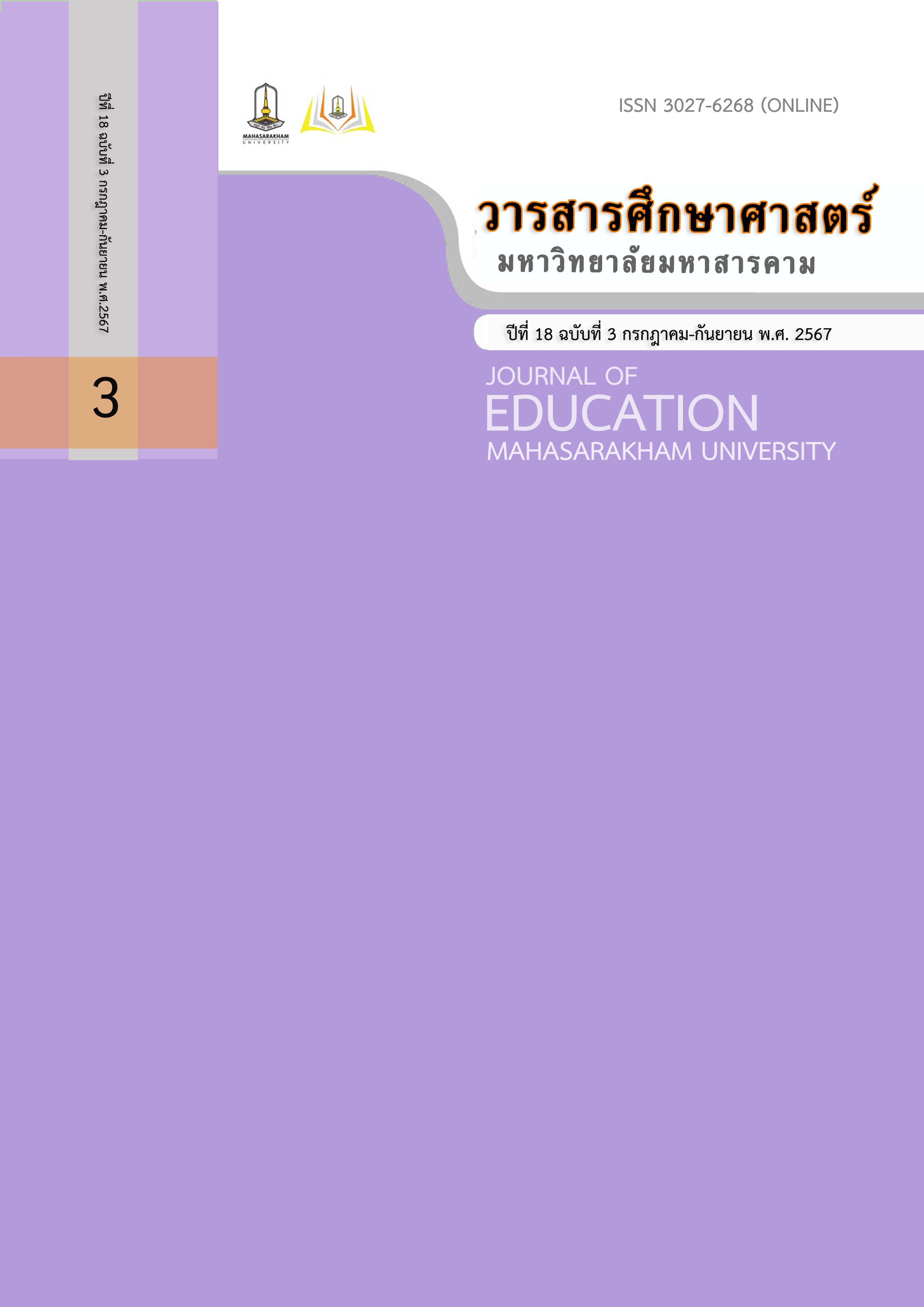EFFECTS OF USING THE PROCESS WRITING APPROACH ALONG WITH THE SCAMPER TECHNIQUE ON CREATIVE WRITING ABILITY FOR PRATHOMSUKSA 6 STUDENTS
Main Article Content
Abstract
The purposes of this research are as follows: 1) to compare the creative writing abilities of Grade six students before and after studying and using the process writing approach along with the SCAMPER technique on creative writing ability, and 2) to compare the creative writing abilities of grade six students who received the learning management process and writing approach along with SCAMPER and a criterion of 70%. The sample group in this research included 15 grade six students at Wat Nong Krabain School by purposive sampling. The research tools were divided into 2 types: 1) experimental tools, which were learning management plans using the process writing approach along with the SCAMPER technique on creative writing ability, amount to 5 plans, 10 hours; and 2) data collection tool which was a form of measurement of creative writing ability 1 item, difficulty value (p) 0.55 -0.75, discrimination value (r) 0.20-0.80, and reliability value 77. The statistics used in the research were mean, and standard deviation. Test statistics and the Shapiro-Wilk test showed a normal distribution. The research results found as follows: 1) the students who received learning management using the process-writing approach along with the SCAMPER technique on creative writing ability, combined with the SCAMPER technique had an average pre-test score of 8.53 points and a post-test score of 11.27 points - before class and after class, the average score was 2.73 points, 2) students who received learning management using the process writing approach along with the SCAMPER technique on creative writing ability had an average score of 11.27, and 13 students passed the criteria which equaled 80% of all.
Downloads
Article Details

This work is licensed under a Creative Commons Attribution-NonCommercial-NoDerivatives 4.0 International License.
References
กระทรวงศึกษาธิการ. (2551). ตัวชี้วัดและสาระการเรียนรู้แกนกลางกลุ่มสาระการเรียนรู้ภาาาไทยตามหลักสูตรแกนกลางการศึกษาขึ้นพื้นฐาน พุทธศักราช 2551. กรุงเทพฯ: ชุมชนุมสหกรณ์การเกษตรแห่งประเทศไทย.
ขวัญชนก อยู่ศรี. (2564). ผลการจัดการเรียนรู้แบบการสอนเขียนที่เน้นกระบวนการร่วมกับ เทคนิค CIRC ที่มีต่อผลสัมฤทธิ์ทางการเรียนวิชาภาษาไทยและความสามารถในการเขียน สื่อความของนักเรียนชั้นมัธยมศึกษาปีที่ 1. (วิทยานิพนธ์ครุศาสตรมหาบัณฑิต). มหาวิทยาลัยราชภัฏวไลยอลงกรณ์ในพระบรมราชูปถัมภ์, สระแก้ว.
จงกล วจนะเสถียร. (2559). การพัฒนาความสามารถในการเขียนเชิงสร้างสรรค์ของนักเรียนชั้นประถมศึกษาปีที่ 3 โดยการจัดกิจกรรมการเรียนรู้แบบซินเนคติกส์. บัญฑิตวิทยาลัย ภาควิชาหลักสูตรและวิธีสอน, มหาวิทยาลัยศิลปกร, นครปฐม.
ชัชฎา ทรรภลักษณ์. (2561). การพัฒนารูปแบบการเรียนแบบโครงงานโดยใช้เทคนิคแคมเพอร์ด้วยคลาวด์เซอร์วิส เพื่อส่งเสริมความคิดสร้างสรรค์ของนักเรียนมัธยมศึกษาตอนต้น. ครุศาสตร มหาบัณฑิต สาขาวิชาเทคโนโลยีและสื่อสารการศึกษา ภาควิชาเทคโนโลยีและสื่อสารการศึกษา, จุฬาลงกรณ์มหาวิทยาลัย, กรุงเทพมหานคร.
ชัยวัฒน์ สุทธิรัตน์. (2561). นวัตกรรมการจัดการเรียนรู้ ที่เน้นผู้เรียนเป็นสำคัญ. นนทบุรี: พีบาลานซ์ ดีไซดแ์อนปริ๊นติ้ง.
ชุดาภรณ์ แท่นอ่อน. (2553). ผลสัมฤทธิ์ทางการเขียนภาษาอังกฤษโดยใช้การฝึกเขียนแบบเน้นกระบวนการ ของนักเรียนชั้นมัธยมศึกษาปีที่ 6 โรงเรียนดงเจนวิทยาคม สำนักงานเขตพื้นที่การศึกษาพะเยา เขต 1. ครุศาสตรมหาบัณฑิต สาขาหลักสูตรและการสอน, มหาวิทยาลัยราชภัฏเชียงราย, เชียงราย.
ทวิช อัศวตระกูลวงศ์. (2561). ผลของการจัดการเรียนรู้โดยใช้แนวการสอนเขียนแบบเน้นกระบวนการร่วมกับกลวิธี RAFT ที่มีต่อความสามารถในการเขียนความเรียงและะเจตคติต่อการเขียนความเรียงของนักเรียนชั้นมัธยมศึกษาปีที่ 6. ปริญญานิพนธ์ กศ.ม.วิทยาการทางการศึกษาและการจัดการเรียนรู้, มหาวิทยาลัยศรีนครินทรวิโรฒ, กรุงเทพมหานคร.
ทศพล ชาวอุทัย. (2559). การพัฒนารูปแบบการสอนเพื่อพัฒนาความสามารถในการเขียนเชิงสร้างสรรค์ของนักเรียนชั้นประถมศึกษาปีที่ 4. ปริญญานิพนธ์ กศ.ม. วิทยาการทางการศึกษาและการจัดการเรียนรู้, มหาวิทยาลัยศรีนครินทรวิโรฒ, กรุงเทพมหานคร.
พัชนี เจียระผกานนท์. (2558). การใช้สื่อสังคมด้วยเทคนิคการสร้างความคิดใหม่เพื่อพัฒนาความคิดสร้างสรรค์ ของนักเรียนชั้นประถมศึกษาปีที่ 6. วารสารวิชาการศรีปทุม ชลบุรี, 12(2), 147-155.
มณฑนกร เจริญรักษา. (2552). การพัฒนาแบบฝึกทักษะการเขียนเชิงสร้างสรรค์ สำหรับนักเรียนชั้นประถมศึกษาปีที่ 6. วิทยานิพนธ์ปริญญามหาบัณฑิต สาขาวิชาหลักสูตรและการนิเทศ, มหาวิทยาลัยศิลปกร, นครปฐม.
โรงเรียนวัดหนองกระเบียน. (2564). รายงานการประเมินตนเองของสถานศึกษา ปีการศึกษา 2564. ลพบุรี: โรงเรียนวัดหนองกระเบียน.
Bob Eberle. (1996). Scamper: Games for Imagination Development. Waco, Tex.: Prufrock Press.
Fatima Al Qudah. (2018). The Effectiveness of Using Generate Ideas (SCAMPER) Strategy on Improving Ninth Grade Students' Writing Skills at Wadi El Sir Schools in Jordan, Journal of Education and Practice, 9(25), 53-58.
Esma Senel. (2019). The Integration of Creative Writing into Academic Writing Skills in EFL Classes. International Journal of languages Education and Teaching, 6(2), 115-120.
Kelly P.G. (1984). Teaching Writing to Tertiary Level ESL Students. RELC Journal, 15(2), 80-94.


